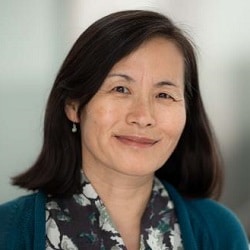
Sako: We may still be in the hype cycle
Oxford University has been awarded a government grant of £213,000 to research the people rather than the technology behind the legaltech boom.
Mari Sako, professor of management studies at Said Business School, said researchers would be interviewing entrepreneurs, investors and innovation managers to help identify links between them.
She told Legal Futures that conversations held on social media, such as Twitter or LinkedIn, would also form part of the study of the legal tech “ecosystem”.
Professor Sako said one aim of the research was to identify the mixture of different backgrounds, qualifications and skills that could be found in a “winning team” in a start-up.
Another was to explore the influence of professional sectors outside the law, like accountancy and insurance, on the legaltech world.
She also said that researchers wanted to compare what was happening in the UK with developments in New York, San Francisco, Canada and Singapore, as well as European countries like Germany and Spain.
The grant from the UK Economic and Social Research Council (ESRC) will fund research on the social networks of key individuals in the legaltech world, and their “career trajectories and typical skillsets”.
Funders of legaltech start-ups and their backgrounds will be studied, to provide “valuable market intelligence” for those currently seeking finance, as will be the extent to which the senior management teams of start-ups depend on their “professional networks” to secure funding and clients.
The study, which will run for 18 months until March 2021, has the support of a number of organisations active in the area, including the UK’s Legal IT Innovators Group, She Breaks the Law, a global network for female innovation managers in legal services launched in April this year, and Thomson Reuters.
“As in other sectors, legaltech will go through a ‘hype cycle’,” Ms Sako said. “I’m not sure we’ve reached the top of it yet – we may still be in it.
“Consolidation is likely to follow after that phase is over. It is likely to be led by those who can afford to consolidate, such as the Big Four accountants, data companies like Thomson Reuters or LexisNexis, or corporations the size of IBM and Google.”
Professor Sako has previously advised the Legal Services Board as member of its research strategy group, considering issues such as the remit of the Legal Services Act, and how quality is measured.
Research on the legaltech ‘ecosystem’ project is due to complete in March 2021.
She added: “Legaltech is still a relatively recent phenomenon. By March 2021 there may be some evolving changes that we need to take into account.”
Oxford University won a £1.2m grant from the ESRC this time last year, to fund a project on unlocking the potential of AI for English law.
Led by the Faculty of Law, the project works with a range of partners, including City firms Allen & Overy and Slaughter and May, barristers from South Square chambers, the Law Society, Thomson Reuters and the Legal Education Foundation.
Meanwhile, Oxford has launched a new option in law and computer science for graduate students on the Bachelor in Civil Law, Magister Juris (MJur) and MSc in Law and Finance courses.
The first “truly interdisciplinary option”, it will be jointly offered by the Law Faculty and the Department of Computer Science.
The course overview says: “As AI and digital technology permeate more of our lives, they increasingly becomes the source of legally significant events. This means that those who study and/or practice law increasingly need to understand the digital context.
“At the same time, those who study computer science and/or develop software increasingly need to understand potential legal consequences of design choices.
“This course will introduce students from both backgrounds to the terrain at the boundaries of their two disciplines. The overarching theme is understanding law and computer science at their intersection.”
The course takes 12 students from each discipline and was over-subscribed this year.